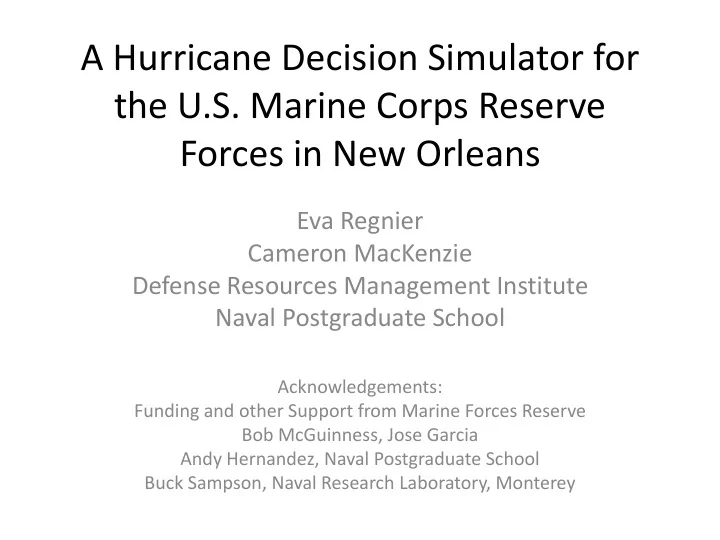

A Hurricane Decision Simulator for the U.S. Marine Corps Reserve Forces in New Orleans Eva Regnier Cameron MacKenzie Defense Resources Management Institute Naval Postgraduate School Acknowledgements: Funding and other Support from Marine Forces Reserve Bob McGuinness, Jose Garcia Andy Hernandez, Naval Postgraduate School Buck Sampson, Naval Research Laboratory, Monterey
Isaac 72 hours before landfall Powell & Aberson (2001)
Isaac 60 hours before landfall Powell & Aberson (2001)
Every storm is different Gustav Humberto August 2008 September 2007 Ivan Katrina August 2004 August 2005
Stewart, Roebber & Bosart (1997)
Challenges in hurricane preparation Task environment Formation of expertise • Too much information • Highly variable context • Dynamic information Many, diverse environmental variables sources • Uncertainty • Few learning opportunities • Dynamic information • Ambiguous feedback sources (frequent updates) • Many decision variables The above characteristics have been shown to reduce the performance of human judgment and the formation of expertise.
Hurricane Decision Simulator A hurricane preparation simulator for MARFORRES emergency managers, with: • Opportunity to “experience” many storms on the order of a one to few hours per storm • Decision model specific to MARFORRES context • Realistic forecasts: Tracks and wind probabilities updated at 6-hour intervals • Feedback on outcomes: A function of decisions and storm
Preparedness Decisions 1. Send advance emergency relocation staff (ERS) to alternate headquarters (96 hours before) 2. Send liaison officers to local municipal emergency operations centers (96 hours) 3. Send rest of ERS to alternate headquarters (72 hours) 4. Activate remain behind element to stay if evacuation ordered (72 hours) 5. Evacuate or shelter in place (60 hours) 6. Transfer command and control to alternate headquarters (48 hours)
Storm Model Slides
Desired Properties of Synthetic Storms • Realism – storms should feel believable BUT features should span realistic ranges; unusual events should occur in synthetic storms not a statistical prediction problem choosing an objective (distance) function is a challenge • Consistency among forecasts e.g. forecast track matches probability plumes • Realistic forecasts Forecast errors consistent with recent NHC forecasts
Questions? • Eva Regnier, eregnier@nps.edu • Cameron MacKenzie, camacken@nps.edu • Paper in the Proceedings
Recommend
More recommend